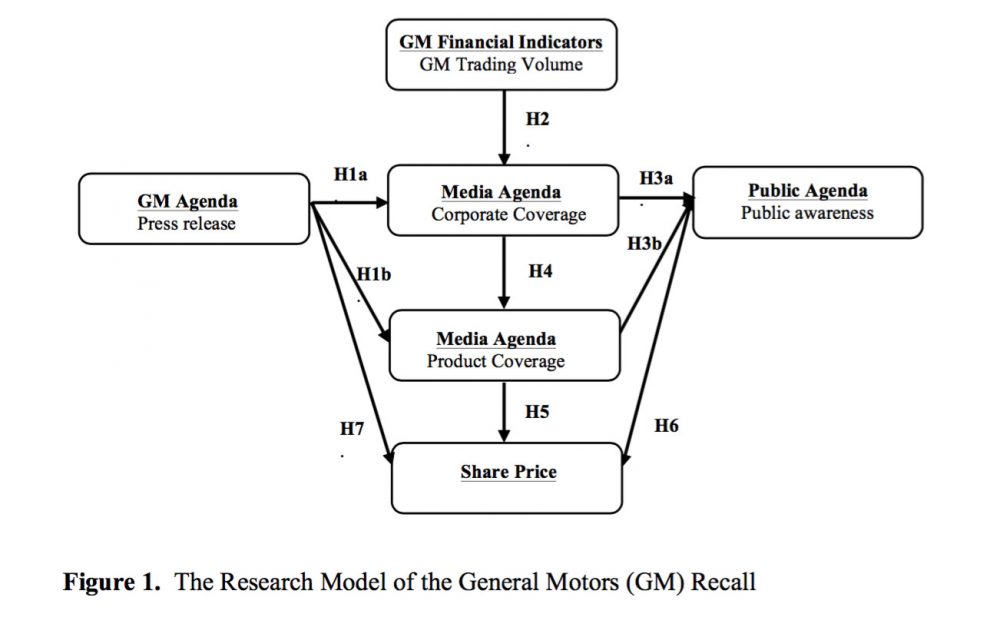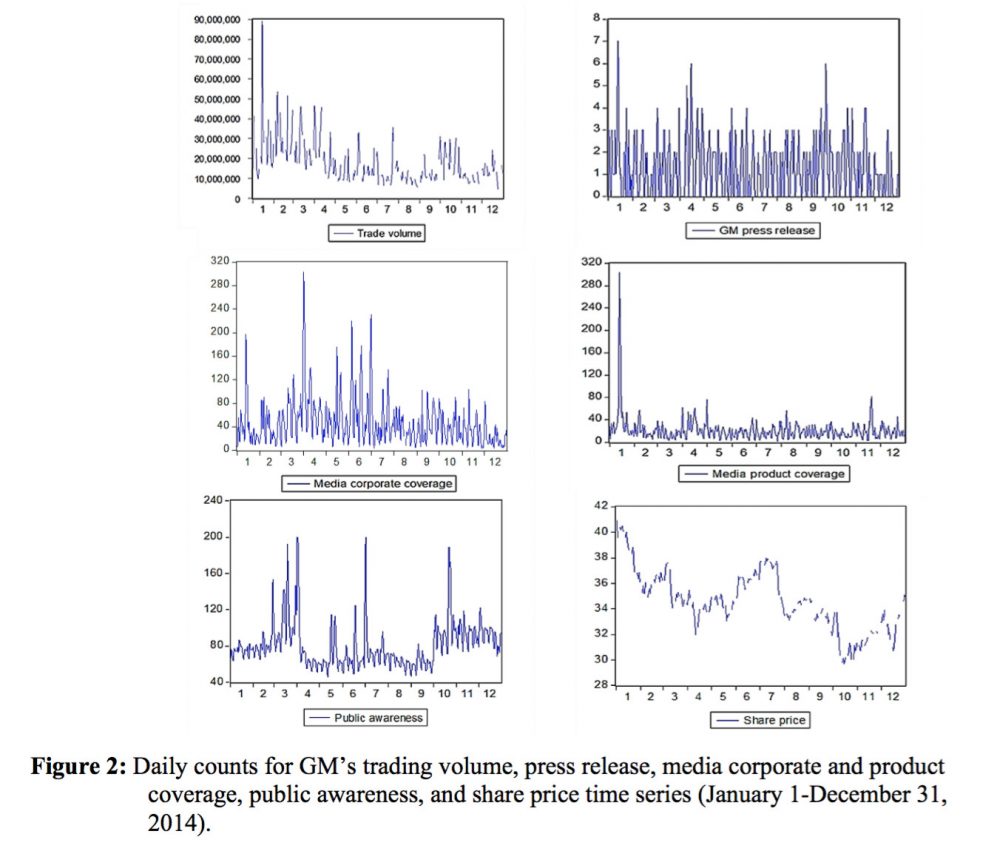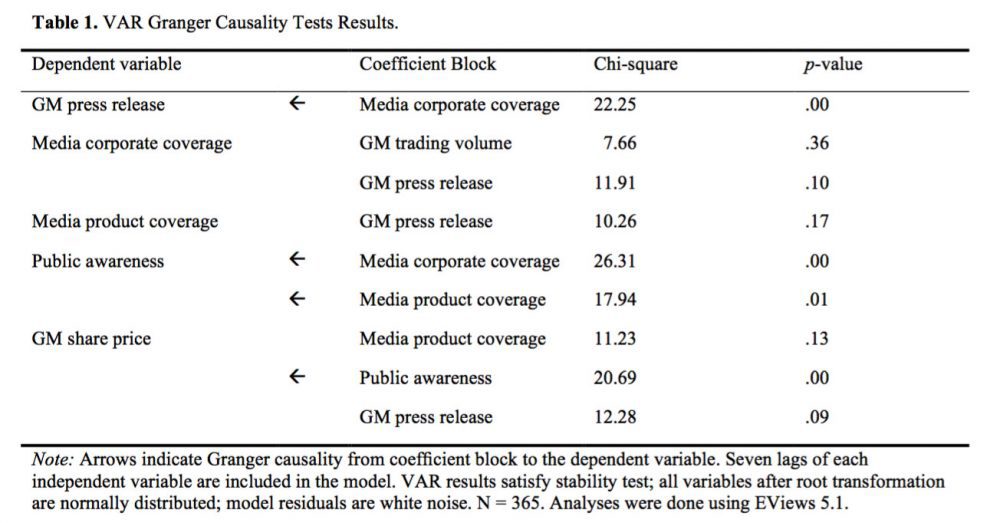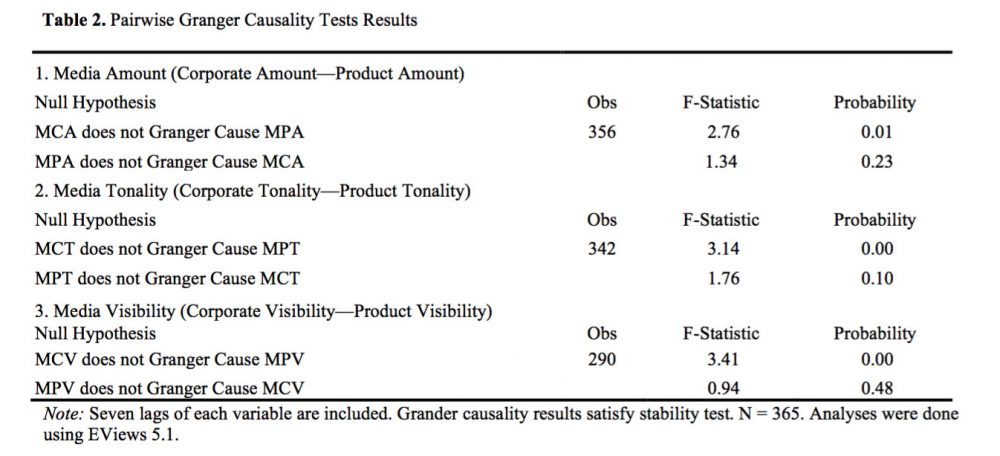Yang Cheng, Doctoral Student at the University of Missouri-Columbia’s School of Journalism
Download Full Paper (PDF): Who is Leading Whom in the General Motors Recall: Understanding Media Impacts on Public Relations Efforts, Public Awareness, and Financial Markets
Executive Summary
This study investigated the antecedents, process, and consequences of news coverage in the 2014 General Motors (GM) recall. To assess causality, a Vector-Auto Regression (VAR) model was applied to examine relationships among GM press releases, media coverage on GM and its products, public awareness, share price, and financial indicators such as trade of volume. The purpose of this research is to yield contributions to a more general understanding of the antecedents, process, and consequences of media news coverage and broaden the scope of agenda-setting and building approaches in a corporate crisis context. The research model, shown in Figure 1 was designed to assess the relationships between the antecedents (i.e., GM trading volume and press release) and media agenda in H1 and H2; test the agenda-setting effects in H3; compare the differences between corporate and product media agendas on amount, visibility, and tonality in H4; examine the stakeholder agenda-setting between media coverage and financial share price in H5, new media agenda-setting between public awareness and share price in H6, and finally measure GM’s public relations impact in H7.

Data were collected through January 1 to December 31, 2014 that spanned over 365 days from four searchable database including trading volume and share price on Yahoo Finance, press releases on the GM official website, news coverage from Factiva, and public awareness on Google trends. In specific, data on news coverage were available from PRIME Research, which was one of global leading companies in media analysis since 1987 (PRIME, 2015). To analyze the casual relationships among GM trading volume, press releases, news coverage on products and corporations, public awareness, and share price in this crisis, the vector auto regression (VAR) model (Freeman, William, & Lin, 1989; Sims, 1980) and pairwise granger causality test (Granger, 1969) were applied for data analysis, which have been widely applied in time series analysis of agenda-setting research (Soroka, 2002).
Figure 2 examines the development of the six major time series over the entire course of the GM recall. Some major features are readily notable. With the exception of GM press releases, all other five variables showed large peaks at some moments. For example, the trading volume of GM stock reached its highest point on January 15, while the media attention for GM and its products already peaked on January 13.

H1 tested the agenda building effects between GM news releases and media coverage on GM and its products. Table 1 shows that in the recall crisis, the amount of GM’s responses did not lead the increase of media coverage on both GM (χ2 = 11.91, p > .10) and its products (χ2 = 10.26, p > .10), but instead, media coverage on GM (χ2 = 22.25, p < .01) significantly shaped the organization’s public relations efforts. Thus, the agenda building effects were reversed in the GM recall crisis. Interestingly, when we further tested the relationship between the trading volume of GM stock and news coverage in H2, it was found that increasing amount of media corporate coverage on GM (χ2 = 7.66, p > .10) could not lead the increase of trading volume of GM. Thus, both H1 and H2 were not supported. The GM trading volume and press releases as the proposed antecedents of news coverage did not influence the media coverage in this crisis.

H3a and H3b examined the classical agenda-setting effects between the corporate media coverage, product media coverage, and public awareness. Data showed that both the corporate media (χ2 = 26.31, p < .001) and product media (χ2 = 17.94, p < .05) agendas significantly predicted the public agenda. Thus, H3 was supported. H4 was proposed to examine the causality between the product media coverage and corporate media coverage on three dimensions: volume, tonality, and visibility. Figure 3 presents the change of media (corporate and product) tonality and visibility over the year of 2014. For the visibility, both the total and average of corporate media visibility were larger than those of the product visibility. For the tonality, the large quantities of negative coverage on GM itself influenced the overall media tonality.

A further pairwise Granger causality analysis was run to test the H4. The F-statistic probabilities from Table 2 indicated that the first null hypothesis was rejected and MCA (media corporate amount) caused a change in MPA (media product amount) (F = 2.76, p < 0.01). For the tonality, the corporate news tonality significantly caused product news tonality (F = 3.14, p < 0.01) at the lag length of 7. For the visibility, the media corporate visibility significantly predicted the product visibility (F = 3.41; p < 0.01). In sum, the H4 was supported. In the GM recall, corporate news led the product news on the dimensions of volume, tonality, and visibility.

H5 examined the stakeholder agenda setting between media coverage and GM share price. Results from Table 1 did not show a significant predication from product coverage to share price (χ2 = 11.23, p = .13), and thus H5 was not supported. However, a further test of new media agenda setting showed a direct and significant influence from public awareness to share price (χ2 = 20.69, p < .01), after controlling the effects from the media and GM agenda. In this way, H6 was supported. Finally, we measured GM’s public relations impact on the financial market. Statistics did not support the significant prediction of GM press releases on share price (χ2 = 12.28, p = .09), so H7 was not supported.
In sum, results revealed that media coverage was a useful predictor, playing a strong role as an agenda-setter, and could lead to setting of public and organizational agenda in the context of the GM recall. Future public relations practitioners may proactively and consistently monitor media coverage on both corporations and products to prevent and manage crises through both online and offline communication. Findings also showed GM lacked influence on media coverage, which challenged the traditional wisdom of agenda-building theory. Several contingent factors such as restructuring of the company, changes in corporate culture, and the high cost of recalls restrained GM from an active and timely response to the ignition-switch problem.
Last but not least, Corporate should avoid becoming the “Bull’s eye”. It was well known that this recall occurred because of the quality of products. However, data showed it was not the products that were most frequently reported by the media: but, media coverage on GM corporate led its product coverage in this crisis with larger quantities, more negativity, and higher visibility of reports. Future GM crisis communication strategies should diverge attention from the corporate brand to products by providing a transparent disclosure of information on certain types of products and minimizing the media coverage on the whole corporation.
Download Full Paper (PDF): Who is Leading Whom in the General Motors Recall: Understanding Media Impacts on Public Relations Efforts, Public Awareness, and Financial Markets



